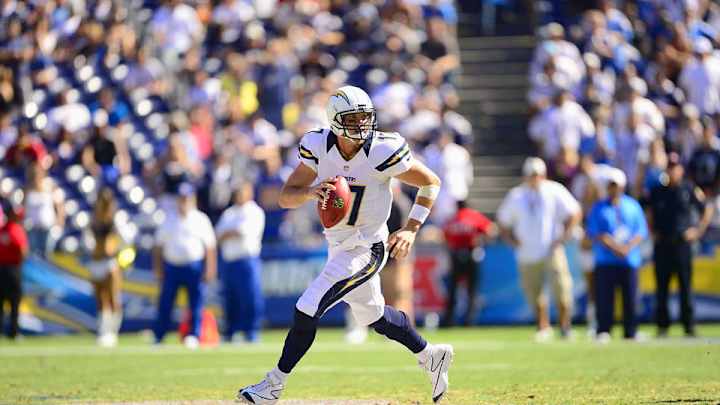The Next Best Thing

SAN DIEGO — Jake Delhomme saw it coming.
Last summer, I had a phone conversation with the former NFL quarterback, who’s now training racehorses in Louisiana and raising his two daughters. We were talking football, and at one point in our conversation, crazy old Jake Delhomme became animated.
“I think Mike McCoy is a hidden gem,” he said of the then-new Chargers coach. “It was very evident in the one year that I didn’t have him as my QB coach in Carolina—2009—I sucked. There’s no other way to put it. He played the position; he understands it.”
I imagined Delhomme slamming down his cup of sweet tea as he said the words. “You just watch Philip Rivers this year,” he finished. “He’ll look brand new.”
Rivers? Philip Michael “Cry me a” Rivers? OK, Jake, I thought. Stick to horses.
Rivers was coming off a 2012 season in which the Chargers finished with a losing record (7-9) for the first time in his career as a starter and his middling 88.6 passer rating wasn’t helping things.
Philip Rivers and Keenan Allen, who had 71 receptions for 1,046 yards and eight TDs as a rookie in 2013. (Dustin Bradford/Getty Images)

Around the same time as my interview with Delhomme, three football men convened in an office at 4020 Murphy Canyon Rd. in San Diego and queued up a digital reel. There was first-time head coach Mike McCoy, the former Broncos and Panthers assistant; offensive coordinator Ken Whisenhunt, fresh off six years as head coach in Arizona; and former Bills quarterback Frank Reich, previously an assistant with the Cards.
CHARGERS PREVIEW:Back for More, Better than Before
They only watched 2012 tape of Rivers, and they saw a quarterback who had the highest completion percentage in football when he got rid of the ball in 2.5 seconds or less, and a 68.8 passer rating when he held onto it longer. They looked at former coach Norv Turner’s offense in motion and wondered aloud about what kind of first, second and third reads Rivers must have been trying to make.
McCoy cautioned his assistants: When we get Philip in the room, go easy.
“You’ve got to be careful, because we didn’t know his progressions in the other systems,” McCoy says now. “I said to the whole staff, lets not over-evaluate this. Lets sit down with him, watch this tape and ask him, ‘What’s your progression on this?’
“Why are you throwing the post instead of this underneath?”
Says Rivers: “It was very back and forth. It was a conversation, and I appreciated that. They didn’t come in and say, this is how we’re going to do it. Take it or leave it.”
The staff outlined a few things they wanted to impress upon the 31-year-old former Pro Bowler. Take what they give you. Do the next best thing.
“When we first talked to him about what we wanted to do, it was just, take what they give you,” McCoy says. “Throw the flat. Throw the flat. Throw the flat. And then throw the post.”
And by telling him to do the next best thing, McCoy was trying to work around Rivers’ predilection for crunch-time interceptions, epitomized by the game on Oct. 15, 2012, against Peyton Manning’s Broncos. Rivers threw four interceptions and Denver overcame a 24-0 deficit to win.
By telling him to do the next best thing, McCoy was trying to work around Rivers’ predilection for crunch-time interceptions.
“He had some interceptions that he forced,” McCoy says. “The competitor comes out and you try to squeeze a ball in there and it gets tipped up. Take the next best thing. Take the open man.”
The focal point of the new attack would be aging tight end Antonio Gates, as it had been since 2004, but they would use the big man in a new way. Gates was targeted 30 times in the short middle third of the field in 2012, according to Pro Football Focus. In 2013, that number jumped to 58.
But the tweaks made all the difference. Numbers like these tell the story of 2013 in San Diego:
- Via PFF, just 2% of Rivers’ passes travelled at least 30 yards in the air, the lowest percentage in the league.
- He threw 17% of his passes to running backs on non-screen plays, third most in the league.
- He let go 315 passes in 2.5 seconds or less, up from 259 the year before.
- He completed a career-high 69.5% of his passes with 32 touchdowns and 11 interceptions, all improvements on the previous three seasons.
Yet McCoy is careful not to describe 2013 as a revamp or a comeback for his quarterback. “He had a ton of success before,” McCoy says. The famously cocksure Rivers agrees.
“I have a lot of respect for Norv,” Rivers says. “He helped me get where I am. I could never throw away all that, and they knew that.
“With all due respect to Jake Delhomme,” he says, “I didn’t stink when I didn’t have Mike.”
CHARGERS POSTCARD: The Word of the Day is ‘Confidence’
Rivers went into offseason film sessions with that same mentality. He was open to new suggestions, but he remains reverent toward Turner, the longtime mentor who helped him reach three consecutive Pro Bowls. McCoy, accordingly, fostered a discussion rather than laying down his philosophy in a take-it-or-leave-it manner one might use with a rookie quarterback.
“Some of the wrinkles they brought and some of the no-huddle stuff was great,” Rivers says, “and they meshed it with what we’ve done in the past.”
On some plays the progressions changed; the first and second reads became more conservative. But occasionally Rivers would let it fly like old times. In Week 6 he threw his third interception of the season on third down during the offense’s first drive. It was a deep ball intended for Eddie Royal, who had stopped running while facing double coverage. Standing not 10 yards in front of Rivers was Gates, without a defender within five yards of him.
Then-Chargers offensive coordinator Ken Whisenhunt and QB Philip Rivers during a break in action against the Texans last September. (John W. McDonough/SI/The MMQB)

In those moments, part of McCoy wants to explode. But he recalls being an assistant in Carolina under John Fox when Delhomme was quarterback, and watching Fox light into the 2005 Pro Bowler for a bad toss.
“John Fox was on him,” McCoy says, “And Jake said, ‘Hold on a minute. Last week I threw that pass for a touchdown, but this week it was six inches behind the guy so it was intercepted.’
“The point is,” McCoy adds, “a guy like Jake or Philip is going to make a whole lot more good decisions than bad, so you let it go.”
Plays like the Raiders’ interception eventually grew less frequent last season. He did not throw an interception in the playoffs and very nearly beat the eventual AFC champion Broncos in the divisional round, losing 24-17. That was with a rookie No. 1 wide receiver in Keenan Allen, one of the two most improved players in the 2014 training camp (along with Pro Bowl center Nick Hardwick.)
WEST COAST STATE OF MIND:Something has changed in the way Philip Rivers thinks and acts
Rivers’ admiration of Allen began in Week 2 last season, when the Chargers were tied in Philadelphia with 1:30 to play and he ran to Allen to go over the hurry-up calls. Says Rivers, “He had a look on his face like, Are you really doing this right now? You don’t think I know what I’m doing right now?”
The Chargers marched down the field and kicked a game-winning field goal with 11 seconds remaining.
After posting 1,046 receiving yards last season with 71 catches, Allen showed up to Chargers camp last month with improved speed: “I’m a deep threat now,” he says.
Perhaps, but we’re less likely to find out as long as Rivers and McCoy keep chasing the next best thing.
* * *
